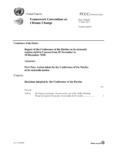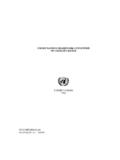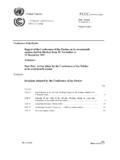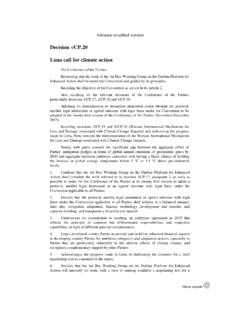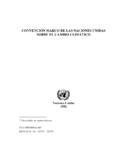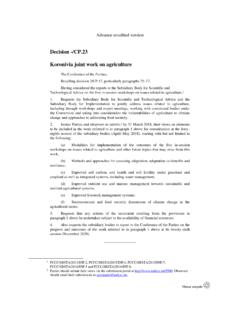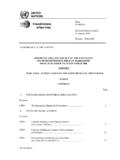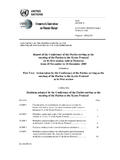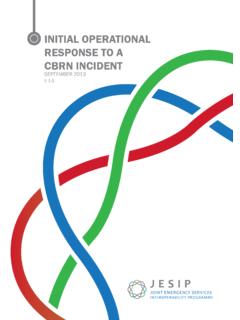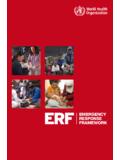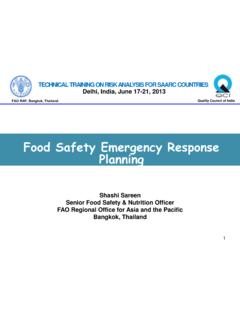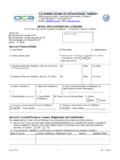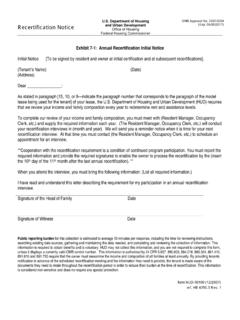Transcription of Climate Change The Fiji Islands Response - UNFCCC
1 Climate ChangeThe fiji Islands ResponseFiji s First National CommunicationUnder the Framework Convention onClimate Change2005 Government of the fiji IslandsFiji s Initial National Communicationpreparedby thePacific Islands Climate Change Assistance Programme(PICCAP) & fiji Country TeamDepartment of Box 2131 Government BuildingsSuva, fiji islandsTelephone: (679) 3311 699, Facsimile: (679) 3312 879 Email: 2005 PICCAP fiji Islands iFOREWORD Global warming has been linked to the large injection of anthropogenic emissions of Greenhouse Gases into the atmosphere, resulting in an imbalance in the world s Climate system.
2 Observations reveal that the earth is getting warmer and mean global temperature keeps on rising annually. World Leaders and Decision-Makers signed the UN Framework Convention on Climate Change ( UNFCCC ) at the Earth Summit in 1992, Rio de Janeiro, in a bid to combat the global warming phenomenon. fiji is a Party to this Convention having ratified it in 1993. The Framework Convention on Climate Change came into force in March 1994. According to Articles 4 and 12 of the Convention, Parties are required to submit their Initial Communication which should include a national inventory of sources of greenhouse gases and its removal by sinks, identification of vulnerable sectors and actions to be taken for sustainable future socio-economic developments without a further increase in the emissions of Greenhouse Gases.
3 In 1998, the Pacific Islands Climate Change Assistance Programme (PICCAP) received financial assistance from UNDP through the Enabling Activities of the Global Environment Facility (GEF). This financial assistance has allowed fiji to prepare its Initial Communication. It gives me great pleasure to present the Initial Communication of the Republic of the fiji Islands to the UNFCCC Secretariat for onward transmission to the Conference of the Parties. Hon. Col. Pio I Wong MINISTER FOR LOCAL GOVERNMENT, HOUSING, SQUATTER SETTLEMENT AND ENVIRONMEN iiEXECUTIVE SUMMARY INTRODUCTION During the 1980s there were growing international concerns that changes in the atmospheric concentrations of a number of gases had potential to affect world Climate .
4 In 1988 the United Nations General Assembly recognised the need to manage human activities that were affecting, or had potential to affect, the world s Climate patterns. Following international negotiations the United Nations Framework Convention on Climate Change ( UNFCCC ) was opened for signature in 1992. fiji signed the convention at its launch in 1992 and ratified it in 1993. The objective of the UNFCCC is to stabilise the concentrations of greenhouse gases in the atmosphere at levels that prevent dangerous interference with the world s Climate .
5 This should be done within a time frame that will allow ecosystems to adapt naturally to Climate Change , to ensure food production is not threatened and to enable economic development to proceed in a sustainable manner (Article 2 of the UNFCCC ). This national communication has been prepared to fulfil fiji s obligations under Articles 4 and 12 of the UNFCCC . These require that all signatories to the UNFCCC communicate to the Conference of the Parties (COP) National Greenhouse Gas Inventories and develop national plans to mitigate Climate - Change impacts and promote measures to facilitate adequate adaptation to Climate Change within three years of the convention coming into force.
6 Because of limited national capacity and financial constraints fiji has not been able to meet this requirement until now. This communication has been prepared in accordance with guidelines issued following the 2nd Conference of Parties (COP2) to the treaty. It presents an overview of national circumstances, particularly aspects that relate to Climate - Change issues, presents a GHG inventory, and analyses mitigation strategies, vulnerability assessment and adaptation assessments and options. An overview of policies and programmes relating to the implementation of the convention is presented, including identified project concepts for further refinement and funding.
7 fiji has been enabled to meet its national obligations under the UNFCCC through support received through the Pacific Islands Climate Change Assistance Programme (PICCAP). PICCAP is a three-year programme funded by the Global Environment Facility (GEF), executed by the United Nations Development Program (UNDP) and implemented through the South Pacific Regional Environment Programme (SPREP), in close collaboration with the UNITAR-administered CC: TRAIN. The implementation of PICCAP in fiji commenced with the formation of the National Climate Change Committee (NCCC) in 1998.
8 The NCCC was established to advise the government on matters relating to Climate Change during the UNFCCC process, and draws on expertise within key government departments. The committee facilitates the work of a technical team comprising a National PICCAP Project Coordinator and technical staff drawn from relevant sectors to participate in the CC:TRAIN training programme. The project coordinator is based with the fiji Department of Environment. iii For the purposes of reporting and future monitoring and as is required by the UNFCCC guidelines 1994 was used as the base year for the Greenhouse Gas Inventory for this national communication to the COP.
9 NATIONAL CIRCUMSTANCES Background fiji comprises more than 300 Islands , and has a total land area of approximately 18 300 km2 and a population of about 773 000 (1996 estimate). The largest island is Viti Levu (10 429 km2), which covers 57% of the total area, and Vanua Levu covers 5 556 km2. Viti Levu is the center of politics and economy of fiji , having Suva (the capital), Nadi (the center of tourism) and farming land for sugarcane as the major crop. Over 90% of the population, both rural and urban, can be considered coastal dwellers, where the vast majority of services, infrastructure, agricultural production and social centres are located.
10 Climate The Climate of fiji is generally categorized as an oceanic tropical Climate in which the dry season is from May to October and rainy season from November to April. fiji s relative location has a strong influence on both seasonal and interannual variations in Climate , particularly rainfall where the southeasterly tradewinds carries moist air into the Islands . fiji is also prone to EL Ni o events and tropical cyclones relative to the positioning of the South Pacific Convergence Zone (SPCZ). During an El Nino-Southern Oscillation (ENSO) event, conditions drier and hotter than normal can be expected from June to August.
